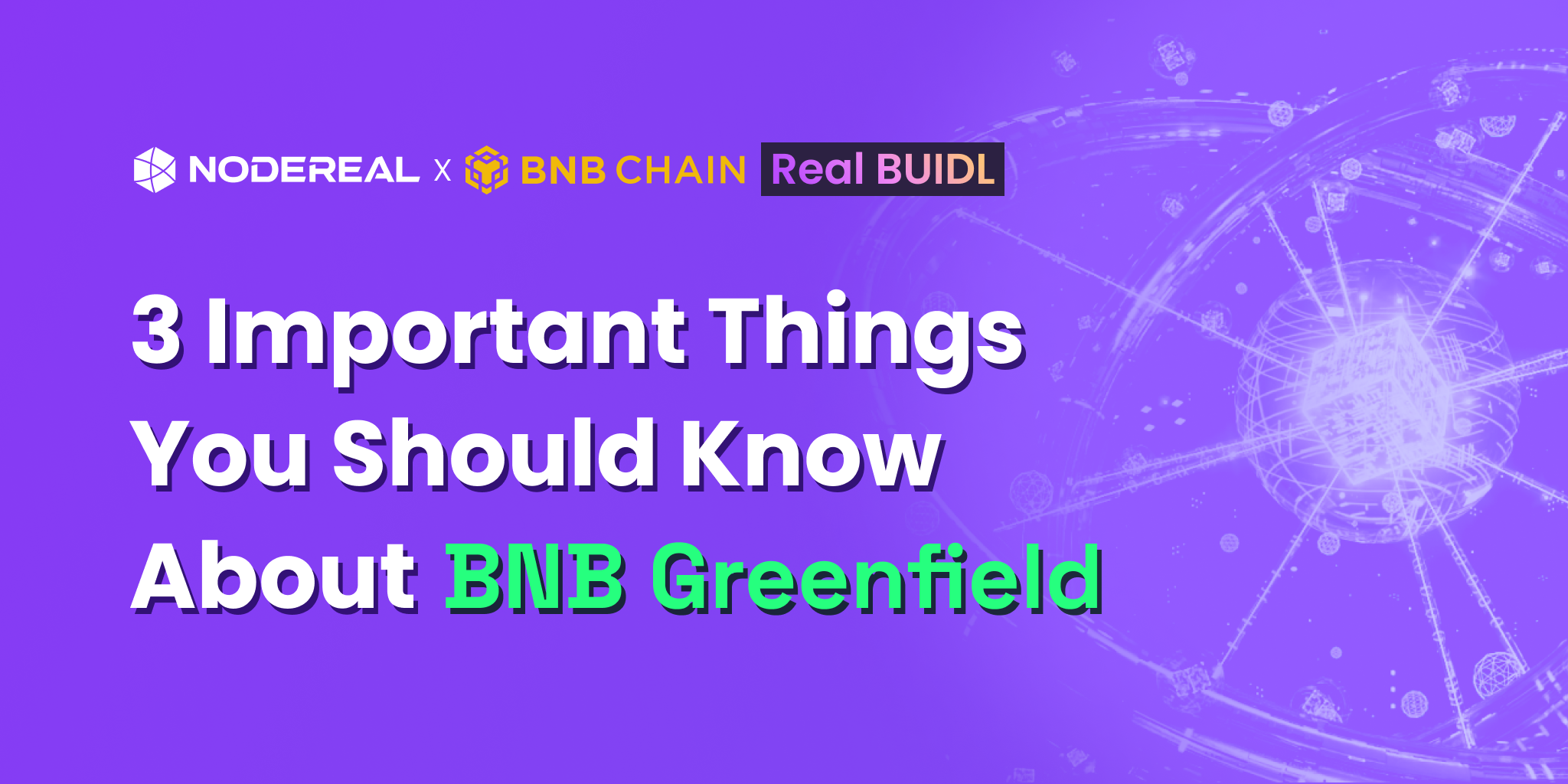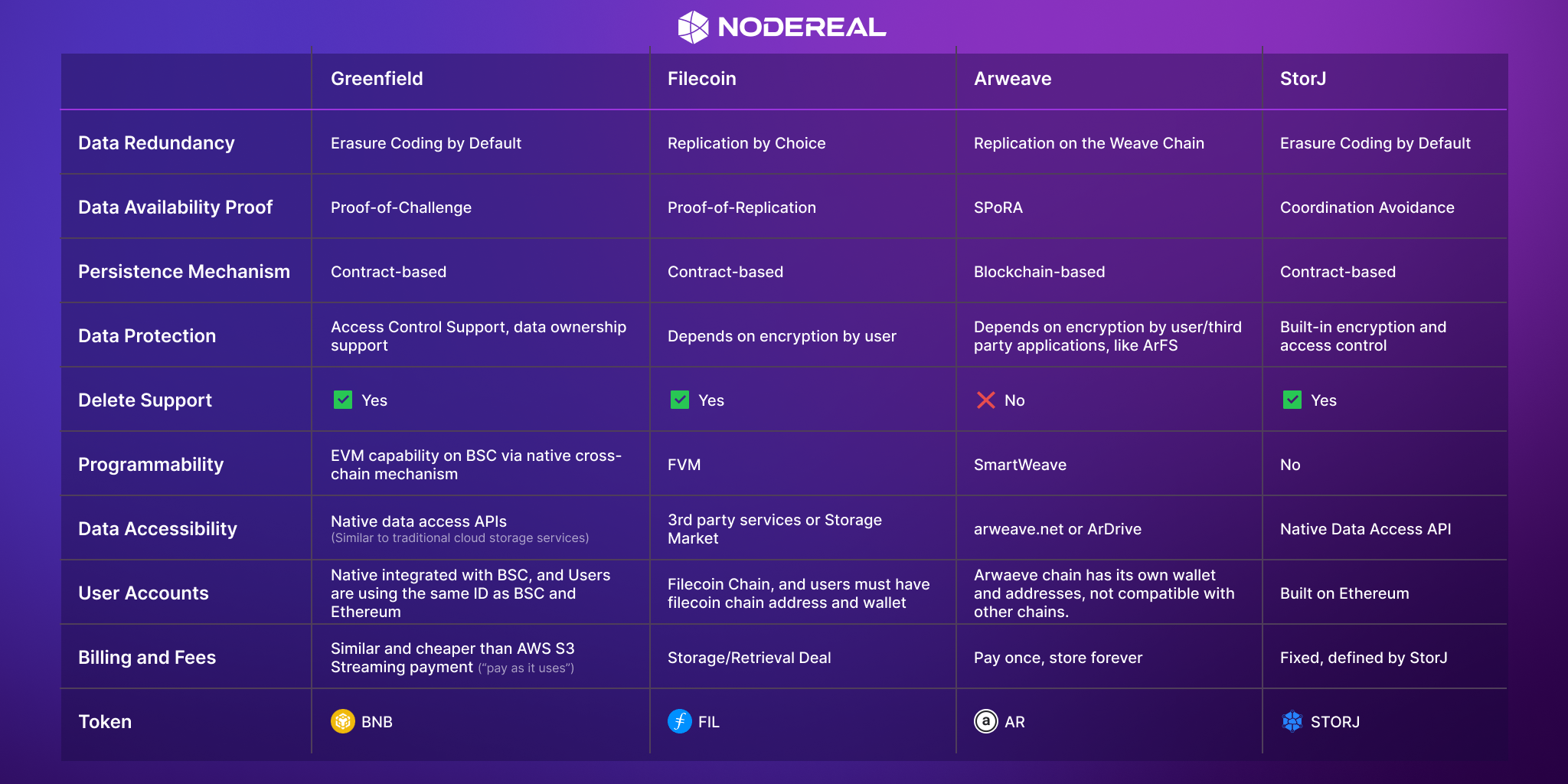3 Important Things You Should Know About BNB Greenfield
BNBChain introduces Greenfield, a decentralized storage network, to address the challenges faced by existing solutions. Let us walk you through the 3 important things you should know about BNB Greenfield.

Why BNB Chain Introduced GreenField Now?
BNBChain is one of the largest blockchain ecosystems with the most active users, with ~1M Daily active addresses recorded in 2022. Leading game and NFT projects utilize various storage solutions including both centralized storage services like AWS S3 or decentralized solutions like Filecoin, Arweave, or Storj, to store their in-game data or NFT data in the form of JPG image or streaming files, etc.
Centralized storage often brings concerns about censorship and monopoly. Existing decentralized solutions like FileCoin, Arweave, and Storj, have their own challenges, including poor user experience, limited programmability, interoperability, low performance, and sustainability of the token economy, which makes mass adoption difficult.
- Programmability: FileCoin and Arweave are independent L1 networks. They are utilizing their own distinct programming models such as the FVM from FileCoin and SmartWave from Arweave, which differ from the widely used EVM, and the developer community for these networks is much smaller than EVM, leading to limited options for development tools and libraries and a high learning curve. Storj even does not have a programmable layer to allow developers to build dApps at all.
- Performance: The FileCoin retrieval process is not always as fast as an IPFS pinning service or traditional cloud storage, and the minimum file size accepted by a Filecoin storage provider is typically several GB. The Arweave network also faces the bottleneck in efficiently uploading and retrieving large files. And if you have used the Storj service and tried to upload the whole folder of your photos, you would have found that the slow response time and long waiting time could make you quite frustrated.
- Privacy and Access Control: Files stored on the FileCoin and Arweave are publicly accessible, meaning anyone can retrieve the file. To ensure access control, the best way to protect your files is to encrypt them. Please note that once a file is uploaded on the Arweave network and added to the blockchain, it cannot be deleted at all.
- Seamlessly integrate into the existing ecosystem: BNBChain has the largest user cases, and most of them are quite familiar with BNB and its dApps ecosystems. FileCoin/Arweave/StorJ requires BNBChain users and dApps to own FIL/AR/STORJ to use their storage service. One major challenge here is the inconsistent address schemas. BNBChain is looking for a solution to allow users worldwide to access all the storage services using exactly the same BSC addresses, which can dramatically minimize the barriers to mass adoption.
Greenfield is a decentralized storage network that aims to solve the problems mentioned above. As part of the BNB Chain, Greenfield utilizes BNB as its utility token.
What are the Key Differentiators between Greenfield and Other DSNs?
Greenfield is designed to have EVM-compatible smart contract integration from Day 1, allowing Web3 builders to start building with their familiar programming models and tools. Additionally, Greenfield allows users to directly use BNB tokens to open accounts and seamlessly integrate with the BNB ecosystem, without needing to understand the underlying complicated mechanism. With replication and parallel optimization, Greenfield offers much faster upload and download speeds for users. Furthermore, users are able to log in with anonymous cryptographic-based keys (IDs) to protect users' privacy at another level of freedom.

Data Redundancy
A storage network’s redundancy strategy must store data in a way that provides access with high probability, even though any given number of individual nodes may be in an offline state. To achieve a specific level of durability (defined as the probability that data remains available in the face of failures), many products in this space (Filecoin, MaidSafe, Siacoin, GFS, Ceph, IPFS, etc.) by default use replication, which means simply having multiple copies of the data stored on different nodes.
Erasure Code (EC) is another way to get efficient data redundancy. A segment is a boundary to perform erasure encoding. By erasure encoding one segment at a time, it allows streaming the processing of the object upload without waiting for the whole object payload to finish. Erasure Coding breaks the object into segments and saves the segments into multiple nodes, but the segmentation and rebuild are computing-intensive, usually providing slower performance. Greenfield introduced Parallel processing based on shard size for the optimal speed.
Replication usually provides better performance compared with Erasure Coding but requires bigger storage space.
Data Availability Proof and Persistency
Filecoin is the incentive layer that targets to provide the permanent storage node, and each time users want to save files, a deal between the clients and storage service provider is needed, and storage service providers need to provide the Proof-Space-Time to guarantee the data persistency, which is computing intensive.
Arweave uses the SPoRA algorithms to incentive storage service providers to replicate data to provide high-speed retrieval service, as it is a blockchain-based data persistence mechanism, all data is saved on the chain, and it is always available by a probability model.
In the Greenfield network, if any storage service provider does not behave honestly, the provider will be punished economically, and the node will be slashed. This makes the consensus proof more efficient.
Greenfield validators and challengers perform the “challenge” in a similar way as ordinary users download the data. Not only is the data availability and redundancy guaranteed, but the service speed is also checked: validators may vote against the SPs that respond to the requests slowly. This will ensure two points at the same time: the challenged SP will not have enough time to get the data from other SPs to recover the data it should possess, and also the challenged SP should maintain the service quality on bandwidth and latency.
Data Accessibility
While Filecoin users have to use 3rd party services or Retrieval Market to obtain the data and most Arweave users download data from arweave.net or ArDrive, Greenfield SPs provide data access APIs directly, which is similar to StorJ.
The APIs are based on the “Universal Endpoint” protocol, so that users can get the data by accessing the endpoints of any SPs. The object reference can be object ID or bucket name plus object name. It is more friendly to dApps, especially the developers from Web2 domains, while Arweave asks users to use transaction ID and Filecoin asks for CID.
Greenfield SPs implemented a sharding by client buckets and target to provide access performance similar to traditional cloud storage services, which should be much faster than existing DSN solutions, such as Filecoin’s Retrieval Providers and Arweave Gateway.
What is more innovative, BNB Greenfield introduces the concepts of data ownership and access permissions into DSN and makes it programmable with BSC smart contracts via the cross-chain and potential off-chain computing scenarios in the future. This brings much more business possibilities for the data economy.
Programmability
Filecoin and StorJ lack programmability at this moment, although the FVM is under development and will be released soon. FVM aims to be almost compatible with EVM but with minor differences.
Arweaves’s SmartWeave is not compatible with EVM, developers need to learn the SmartWeave programming model to develop on the chain.
Greenfield is fully integrated with BNB Ecosystem and fully compatible with EVM from day 1. It supports
- Smart Contract integration is considered to be supported on day 1, instead of at a later stage. So many friendly design Smart Contracts can use primitives to operate almost all aspects of a data object stored on Greenfield;
- As Greenfield is reusing the smart contract capability on BSC via a native cross-chain mechanism and the same address format, the data economy can be easily and seamlessly combined with other existing assets, dApps, and users on BSC, with much more composability.
What can Web3 Builders Benefit from BNB Greenfield?
- Native Integration with BSC
With native integration with BSC, the address format of Greenfield is identical to the BSC, which makes the data economy can be easily and seamlessly combined with the existing assets, dApps, and users. As BSC has the largest daily active users compared with other chains, Greenfield builders can have the privilege to access the huge user base from day 1.
2. Programmability
By reusing the BSC smart contract capability, the Greenfield is designed with smart contract integration from day 1, which provides much more flexibility for web3 developers.
3. Consistent Data Accessibility
Unlike other DSN, the storage providers of Greenfield provide service directly, users do not need to depend on third-party storage services.
4. Flat Learning Curve
Unlike CID or Transaction ID used by other DSN, the Greenfield provides data access via either object bucket+name or the object ID to identify the data, with which the web2 developers are more familiar.
5. High Performance
By using sharding on the buckets, Greenfield can provide a high-performance data service, which is faster than existing DSN solutions.
6. Enable Data Ownership
BNB Greenfield introduces the concepts of data ownership and access permissions into DSN and makes it programmable with BSC smart contract via the cross-chain and potential off-chain computing scenarios in the future. This brings much more business possibilities for the data economy.
7. Computing Efficiency
With an on-purpose choice of “Proof-of-Challenge”, by which any service provider that can not provide stable and reliable service will be slashed and punished, Greenfield systems can avoid intensive computing required consensus algorithms like “Proof-of-Spacetime” and “Proof-work”.
8. Pay-as-you-use
Greenfield adopts the “Stream Payment” based billing, which gives the users the freedom to pay as it uses for data storage and retrieval.
As one of the core contributors to BNBChain, NodeReal serves as the major infrastructure provider for Greenfield. For more information, please add the Greenfield Whitepaper to your reading list. Let’s BUIDL for Real!
About NodeReal
NodeReal is a one-stop blockchain infrastructure and service provider that embraces the high-speed blockchain era and empowers developers by “Make your Web3 Real”. We provide scalable, reliable, and efficient blockchain solutions for everyone, aiming to support the adoption, growth, and long-term success of the Web3 ecosystem.
Join Our Community
Join our community to learn more about NodeReal and stay up to date!

